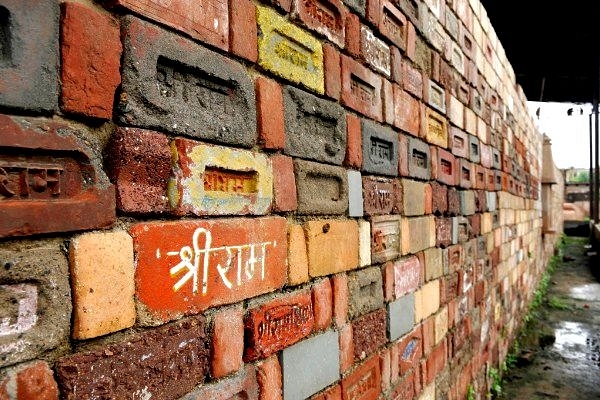Politics
Sorry, But The Mediation ‘Deal’ On Ram Mandir Is Simply Not Good Enough
- There is a case for mediation, dialogue and compromise between Hindus and Muslims, but it cannot be done if the idea is to bury the past as if it did not happen.
- A compromise can only be built on a solid foundation of truth, and only truth can be the basis for genuine reconciliation.

Bricks with Sri Ram written on them in Ayodhya. (Burhaan Kinu/Hindustan Times via GettyImages)
With just weeks to go before the five-judge Supreme Court bench gives its final verdict in the Ram Janmabhoomi case, there seems to be a premature assumption among some Hindu groups that the Ram Mandir will be a reality soon. This impression has been strengthened by reports that the three-member mediation panel headed by former Supreme Court judge F M I Kalifulla, which has Sri Sri Ravi Shankar and Sriram Panchu as members, has found a middle ground to settle the dispute out of court.
The broad contours of the deal seem to be this: the Sunni Waqf Board, but not necessarily other Muslim groups, will end its claims to the core 2.77 acre Ram Janmabhoomi land, in return for which the court to uphold the validity of the Places of Worship (Special Provisions) Act 1991, the right to build a new mosque elsewhere in Ayodhya, permission to restore other old mosques and handover of mosques now under the control of the Archaeological Survey of India (ASI) to Muslims.
This is a bad deal, even if a Ram Mandir can now be seen as within reach and construction can begin early next year.
It’s a bad deal for the Hindu side for three reasons.
First, it implies that the Supreme Court will have to freeze any challenges to the Places of Worship (Special Provisions) Act 1991, which was brought in by the P V Narasimha Rao government in order to restrict temple-mosque disputes to only the Ram Mandir. It was always unfair, as it prevented Hindus from seeking full possession of the Kashi and Mathura temples, which were deliberately targeted by Muslim rulers to establish supremacy.
Unlike the Ram Mandir, these two sites need almost no proof to establish Hindu rights. This law clearly prevents the correction of a manifest civilisational injustice, and bars Hindus from even seeking remedies for the restoration of these two holiest of holy sites. Banning even a court challenge to the Narasimha Rao-era law is unacceptable. The Supreme Court bench cannot make that law unchallengeable without first hearing all sides on it.
Second, by apparently giving in on the Ram Janmabhoomi site, the Muslims get rights to not just build one mosque, but ensure investment in several other mosques, not to speak of being allowed to grab many other mosques now under ASI control. Many of these mosques were built over destroyed Hindu temples, and giving them back to Muslims would mean that for the sake of one Ram Mandir, scores of other mosques similarly built over Hindu places of worship will be deemed to be legitimate. This is not civilisational justice.
Third, and this is the most important point, treating this as some kind of deal to seal communal amity is wrong in principle. The real issue is not whether Hindus get possession of the Ram Janmabhoomi site or not, but the complete refusal by 'secularists' and Muslim parties to acknowledge that Islamic iconoclasm caused huge damage to the Hindu psyche.
While it is fair to say that blame for what an Aurangzeb, Sikandar Butshikan, Alauddin Khilji or Tipu Sultan did should not be laid at the door of today’s Muslims, surely history should not deny this reality? If the Muslims of today are not told what happened in the past, what is the guarantee that communal amity will reign in future? Communal amity cannot be built on the sands of complete denial or ignoring the truth. If every German is told of the damage done by Nazism, why should Indian Muslims be shielded from learning about the iconoclasm and destructive tendencies of past Islamic rulers?
At the very least, we need a truth commission to establish what happened, and rewrite our history books to reflect these facts. Books like those written by Sita Ram Goel (Hindu Temples: What Happened to Them, in two volumes) and Meenakshi Jain (Rama and Ayodhya, The Battle for Rama) ought to be required reading in colleges and history courses.
India’s Left historians have done enormous damage to Hindu-Muslim relations by seeking to hide the truth and building false equivalence between the consistent and repeated damage done to temples by Muslim rulers and the occasional case of vandalism by Hindu rulers. They seek to hide something from Muslims what they probably know in their heart of hearts: that Islam is iconoclastic, Hinduism is not. This means Muslim rulers are more likely to have damaged temples than vice-versa.
There is a case for mediation, dialogue and compromise between Hindus and Muslims, but it cannot be done if the idea is to bury the past as if it did not happen.
A compromise can only be built on a solid foundation of truth, and only truth can be the basis for genuine reconciliation.
Introducing ElectionsHQ + 50 Ground Reports Project
The 2024 elections might seem easy to guess, but there are some important questions that shouldn't be missed.
Do freebies still sway voters? Do people prioritise infrastructure when voting? How will Punjab vote?
The answers to these questions provide great insights into where we, as a country, are headed in the years to come.
Swarajya is starting a project with an aim to do 50 solid ground stories and a smart commentary service on WhatsApp, a one-of-a-kind. We'd love your support during this election season.
Click below to contribute.
Latest